

By Tim Gillespie
Seventh chords have always been a gateway to extended and advanced chords. They are by far the most often used four note chord in popular music today. Most of the basic chords are three note chords that have been dressed up by adding additional notes already present in the chord.
Seventh chords are not fancy three note chords. They are true four note chords based on basic chords. I have always been impressed that the seventh degree in a major diatonic scale presents so many problems for beginner and intermediate lead guitarist that the seventh degree is very often ignored. In fact much of the allure of standard pentatonic scales stems from the fact they eliminate the seventh degree along with the fourth degree.
But when we create seventh chords we intentionally seek out this renegade seventh degree and combine it into chords to achieve this jazzy effect. How can a troublesome note provide such a lift to chords that we name an entire family after it? The answer is the note is quite marvelous in what you can do with it as well as where it lives in the scale.
I really did avoid seventh chords for several years at first. They always challenged my ability to make sense of what I was
learning and playing. I could never predict the sound I would get, let alone figure out how to apply them.
The biggest change occurred when I played long enough to get all the speed issues out of the way long enough to slow down and listen to what I was doing. When I did, the flavor of the chord family started to pour out and enter my musical creative processes.

 Before
we look at the chord structures, lets take a look at the basic diatonic
scale and examine how the seventh degree works.
Before
we look at the chord structures, lets take a look at the basic diatonic
scale and examine how the seventh degree works.
The seventh degree is situated directly next to the keynote. This creates a very unstable situation because of the gravitational tug of the keynote. Everything in the key is striving to resolve to tonic. The seventh degree, because of its proximity, has a very tough time competing with the tonic note. So every time someone stumbles into the seventh degree in an improvised lead, it can have a negative and unpredictable effect on the line.
It is not always negative, the seventh degree can intensify the need to resolve. It can create a strong tension in the music and add a sophisticated secondary accent.
When you construct a chord on the diminished note using the standard construction technique for basic chords, you end up with the only diminished chord in the line. A diminished triad is constructed of two minor triads. If you look at the other basic triads, you can see how unusual this diminished form is.
It is the only chord in the progression inside a key that is built with two minor triads and results in an imperfect fifth. All of the other chords result in a perfect fifth. Each chord uses both a minor triad and a major triad except this diminished chord.
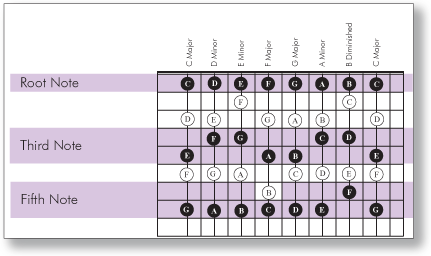 So within the
basic chords in a key, the seventh note provides a disruptive influence.
But in these instances we are dealing with only three note chords. Three
note chords imply two triads stacked to create a chord. But when you add
another note, you also add another triad. This means in order to create
a seventh chord, you must stack at least three triads in order to create
it and this provides a level of complexity that can be hard to control.
So within the
basic chords in a key, the seventh note provides a disruptive influence.
But in these instances we are dealing with only three note chords. Three
note chords imply two triads stacked to create a chord. But when you add
another note, you also add another triad. This means in order to create
a seventh chord, you must stack at least three triads in order to create
it and this provides a level of complexity that can be hard to control.
7th Chords, A Clashing Of Construction Systems
The first step in controlling something is to understand it. And seventh chords can be understood if you look inside the structure and notice how they are differentiated.
This group of chords can be broken into three main groups. The seventh group, the minor seventh, and the major seventh group. Most of the other seventh forms are a derivative of one of these groups. When you see how each group fills a certain niche, they begin to take shape as a family and they also begin to make sense musically.
![]()
![]() In
order to see this, we will take a look at how each of these forms is created.
All chords are built using thirds. A third contains two notes separated
by either three or four frets.
In
order to see this, we will take a look at how each of these forms is created.
All chords are built using thirds. A third contains two notes separated
by either three or four frets.
A third can be either major or minor. If you flat a minor third, you get a second. If you sharp a major third, you get a fourth.
When you build a chord, you stack these triads and form one of four different chords. They can be either major, minor, diminished or augmented.
We have briefly talked about diminished triads, you can build an augmented chord by stacking two major triads.
But what we are going to focus on are the major and minor triads.
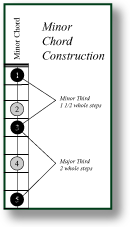
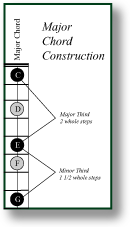 You
can see that stacking a major third and then a minor third yields a major
triad.
You
can see that stacking a major third and then a minor third yields a major
triad.
Stacking a minor third and then a major third yields a minor chord or triad.
The first or lowest third is what determines whether a chord is major or minor. A minor third first, produces a minor chord. If the first third is a major third, then the chord will most likely be a major chord. Remember you have to account for diminished and augmented configurations.
When we build seventh chords we build them on top of one of these chords.
If you take a good look at these intervals, you will see there are limited options for changing the configuration of the chords. This will become more evident when we stack another third on top of these. When we do that you will quickly see how and why seventh chords are made.
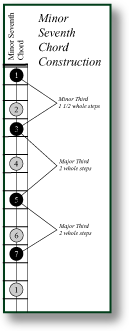
 This
is the first of the three chords we will examine. Notice this is a minor
seventh chord. The first identifying marker in this chord is the first
(lowest) third. It is minor. This gives the chord the minor designation,
just like the minor chord listed above.
This
is the first of the three chords we will examine. Notice this is a minor
seventh chord. The first identifying marker in this chord is the first
(lowest) third. It is minor. This gives the chord the minor designation,
just like the minor chord listed above.
The second third is major but other than eliminate diminished or augmented construction, it only defines what we already suspected, a perfect fifth. This is why the fifth is sometimes omitted. You can easily infer this note. The third degree is more important in that it determines the bacis major or minor configuration, so it is often kept in.
The third third is interesting (5 to 7 degrees). It is a minor third. The order of thirds is minor, major and minor. This is a minor seventh chord. But also notice the minor third is not where the seventh degree of the scale is located. This is a flatted seventh note. Remember in a natural major scale, the seventh degree is right next to tonic. That means this chord violates the key! This is the usual place for a person new to chord construction to see their first violation. If you are trying to understand how this fits in the big picture, you might have to pour over much material to understand it. But it really is easy. There is only one other note this chord can use other than this flatted seventh. It could use a natural seventh note. This would change the third from minor to major. And it would not violate the key. That kind of chord is called a minor major seventh. It is not all that common to run across.
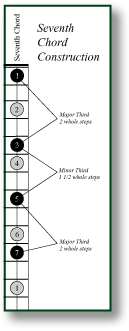 The next chord
we will examine is a seventh chord. This chord is built by stacking a
major third, then a minor third and then another minor third. The only
difference between this chord and the minor seventh chord above is the
base chord is major rather than minor.
The next chord
we will examine is a seventh chord. This chord is built by stacking a
major third, then a minor third and then another minor third. The only
difference between this chord and the minor seventh chord above is the
base chord is major rather than minor.
Other than that, the chords are the same. So this first differentiation is by changing the first third and keeping the other two the same.
This also points out that the lower third still controls whether the chord is major or minor.
You might be tempted to think this chord falls outside the key and it does. However it also falls inside the key. It all depends on what degree you build this form on. If you build it on the fourth degree of the scale, it violates the key. If you build it on the fifth degree, there is no violation. The last diagram illustrates this. I suggest you pour over it.
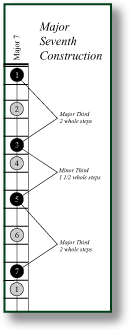
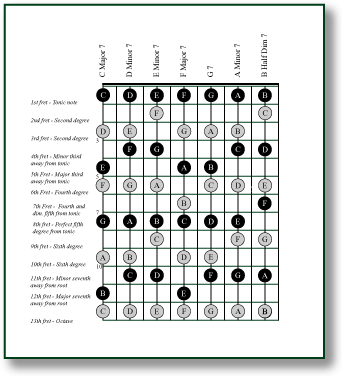 The last chord
we are going to examine is the major seventh chord. This one should help
you start to put it all together.
The last chord
we are going to examine is the major seventh chord. This one should help
you start to put it all together.
This chord has the same lower two thirds, but the upper third is now major. This is a major chord with a major third stacked on top of it. This starts to hint that the different alterations to this group of chords is covered by all the other deviations I referred to earlier. There are only so many alterations you can perform.
It starts to help make sense of all the thing you can do with this family of chords. And you can actually make selections based on what you are trying to doand what sound you are after. This will not happen right away, but the basics are here.
You can construct the other forms too. There are some diminished forms that are interesting. You can also keep the seventh where it is and alter the fifth. This will give you a 7-5 or a 7+5. There are a bunch of alterations but they mostly boil down to these forms.
Learn how to build songs the easy way!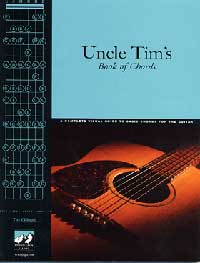
Building songs is actually very easy when you work inside a key! The key determines what chords work and which ones do not fit.
By examing pictures of keys, you can quickly determine what chords are in a key and by using cascades that cover the entire fretboard, you can easily pick the right chord in the exact right spot on the fretboard.
There is nothing like it and nothing that can make composing songs as easy as this. For $20, you can have a resource that will always show you all the choices for where you are working. Pick up a copy today.
eBooks are delivered instantly!
If you were going to adhere to the scale of C major and build the
seventh chords too, you would end up with a diagram like this. The black notes are the notes of the chords. All of these chords adhere to the key and three different chord types are present.
All of this theory fits into the mechanics of keys very nicely. It helps to clarify what chords work where.
There is much to know about this and it will take a while to understand it enough to use it and take advantage of what is possible.
So take a good look at the possibilities and examine what in songs might be accentuated by adding some of these alterations.